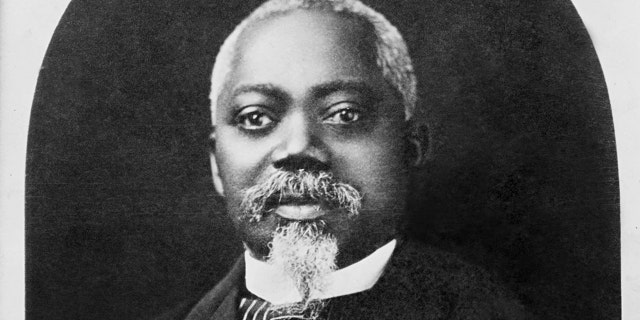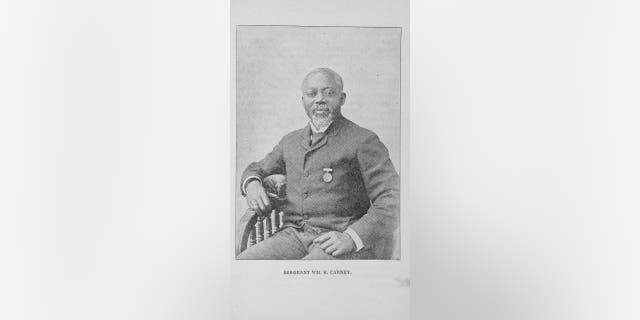
Sgt. William H. Carney was the first African American to be awarded the Medal of Honor, the nation’s highest military decoration, on this day in history, May 23, 1900, for his efforts at protecting the American flag during the Civil War, says History.com.
The Medal of Honor is the United States government’s most prestigious decoration, as the National Archives has noted.
Established by a joint resolution of Congress in July 1862, the award is bestowed upon “a person, who, while a member of the armed services, distinguishes themselves conspicuously by gallantry and intrepidity at the risk of their life above and beyond the call of duty, while engaged in an action against an enemy of the United States.”
ON THIS DAY IN HISTORY, MAY 22, 1992, JOHNNY CARSON MAKES HIS FINAL APPEARANCE ON ‘THE TONIGHT SHOW’
Sgt. Carney was born into slavery. He joined the 54th Massachusetts Volunteer Infantry Regiment during the Civil War, said the National Museum of the U.S. Army.
“As his regiment gained the crest of the parapet at the Confederate-held Fort Wagner in South Carolina, Sgt. Carney took up the American flag after earlier color bearers fell and he carried the flag to the fort, rallying and inspiring the men around him,” the museum site notes.

William Harvey Carney (1840-1908), an African American soldier during American Civil War, was the recipient of the Medal of Honor for his bravery during the 1863 Battle of Fort Wagner, W.E.B. Du Bois Collection. (Circa Images/GHI/Universal History Archive/Universal Images Group via Getty Images)
Despite being seriously injured, Sgt. Carney said, “Boys, I only did my duty; the old flag never touched the ground,” according to the same source.
Sgt. Carney’s regiment engaged in its first battle at James Island, South Carolina, on July 16, 1863 — and the Battle of Fort Wagner followed two days later.
Col. Robert Gould Shaw and the 54th led the 5,000 Union troops who marched on the fort in the evening of July 18, 1863.
“Boys, I only did my duty; the old flag never touched the ground.”
At the fort, says the U.S. Army site, 1,800 Confederate soldiers prepared for the attack and the Union Army’s naval fleet battered the fort with cannon fire and weakened their defenses.
“When the 54th arrived at the fort, the Confederate Army showered them with bullets. Shaw adjusted the regiment’s advances and took them through the moat and up the slope leading to the fort,” the U.S. Army site indicates.

Sergeant William H. Carney, 1897. Creator: Unknown. (Heritage Art/Heritage Images via Getty Images)
As the battle continued, Col. Shaw perished. His regiment raged on, but the 54th suffered heavy casualties with about half their soldiers killed, wounded, captured or missing in action, the site says.
The Union Army was forced to withdraw from the battle — and this battle serves as a pivotal example of African American valor during the Civil War.
“The actions of the 54th inspired even more Black men to enlist,” says the site.
The movie “Glory” is a recreation of the assault on Fort Wagner.
As the men advanced, they were immediately hit by a barrage of canister, musketry and shelling from the fort, says The Military Times.
“He knelt down to gather himself for action, still firmly holding the flag while bullets and shell fragments peppered the sand around him.”
A bullet struck the 54th’s brave sergeant, and as the wounded man faltered, Carney threw down his gun, seized the flag and moved to the front of the 54th’s assaulting ranks.
“He soon found himself alone, on the fort’s wall, with bodies of dead and wounded comrades all around him. He knelt down to gather himself for action, still firmly holding the flag while bullets and shell fragments peppered the sand around him,” the site chronicles.
MEET THE AMERICAN WHO WROTE ‘THE BATTLE HYMN OF THE REPUBLIC’
Although this notable act of heroism happened in 1863, Sgt. Carney was not awarded the country’s highest military honor until May 23, 1900.
Born in Norfolk, Virginia
Sgt. Carney was born on Feb. 29, 1840, in Norfolk, Virginia, according to the National Museum of the U.S. Army.
His father, William Carney Sr., fled enslavement on the Underground Railroad and eventually, says the site, the elder Carney settled in Massachusetts, where he worked and bought his family’s freedom.
By the late 1850s, the now-free Carney family moved to New Bedford, Massachusetts, where young Carney attended school and learned to read and write, according to the same source.

Memorabilia from Sgt. William Harvey Carney includes the Congressional Medal of Honor, pictured on Jan. 10, 1990, in New Bedford, Massachusetts. (Mark Wilson/The Boston Globe via Getty Images)
“While he showed an interest in joining the ministry, he saw the onset of the Civil War as a call to serve in the U.S. Army,” says the site.
He reportedly said, “When the country called for all persons, I could best serve my God serving my country and my oppressed brothers.”
Following the passage of the Emancipation Proclamation on Jan. 1, 1863, the 54th Massachusetts Volunteer Infantry Regiment was formed. Then Massachusetts Gov. John A. Andrew led the organization of an all-African American volunteer regiment, notes the Army website.
ON THIS DAY IN HISTORY, NOV. 8, 1864, PRESIDENT LINCOLN DEFEATS GEN. MCLELLAN TO WIN REELECTION
Carney recovered from the wounds he received at Fort Wagner — and when his commanders heard about his conduct, he was promoted to sergeant, noted The Military Times.
Later in the war, the publication reported, the 54th fought a rear-guard action covering a retreat at the Battle of Olustee. Yet Sgt. Carney could not participate in that engagement as a result of his wounds.
Because of his injuries, he was discharged from the Army a little more than a year after the battle, on June 30, 1864, the same source says.
After the Civil War, Sgt. Carney worked as one of the earliest U.S. letter carriers and frequently spoke in public about how he saved the U.S. flag.
After returning home, Carney married Susannah Williams. The couple had a daughter, says the Museum of the United States Army.
After the Civil War, Sgt. Carney worked as one of the earliest U.S. letter carriers and frequently spoke in public about how he saved the U.S. flag, the library of the State of Virginia says.
“In 1897 he received a standing ovation while attending the unveiling ceremony for the Boston monument to Col. Robert Gould Shaw of the 54th Massachusetts,” says the site.
CLICK HERE TO SIGN UP FOR OUR LIFESTYLE NEWSLETTER
Sgt. Carney died on Dec. 9, 1908.
He is buried in New Bedford, Massachusetts.
CLICK HERE TO GET THE FOX NEWS APP
“His memory lives on as a representation of the valor and bravery of the Black Soldiers who served in the Union Army and when Carney died in 1908, the U.S. flag flew at half-mast at the Massachusetts State House,” according to the Library of the State of Virginia.